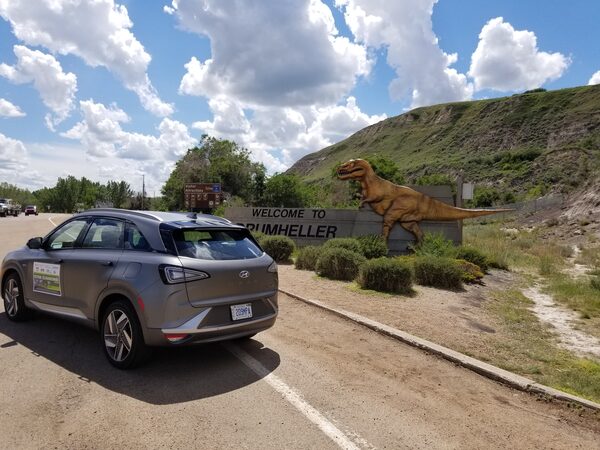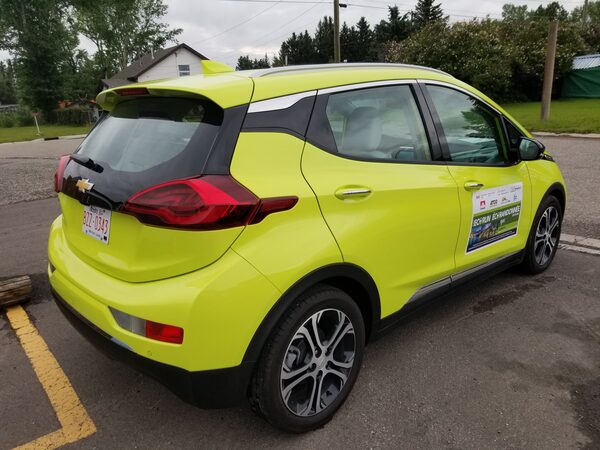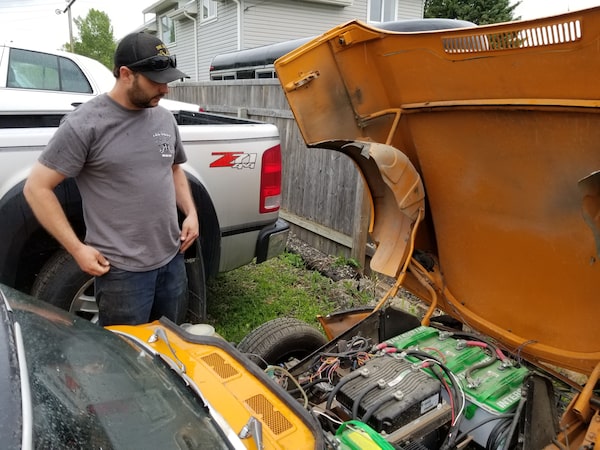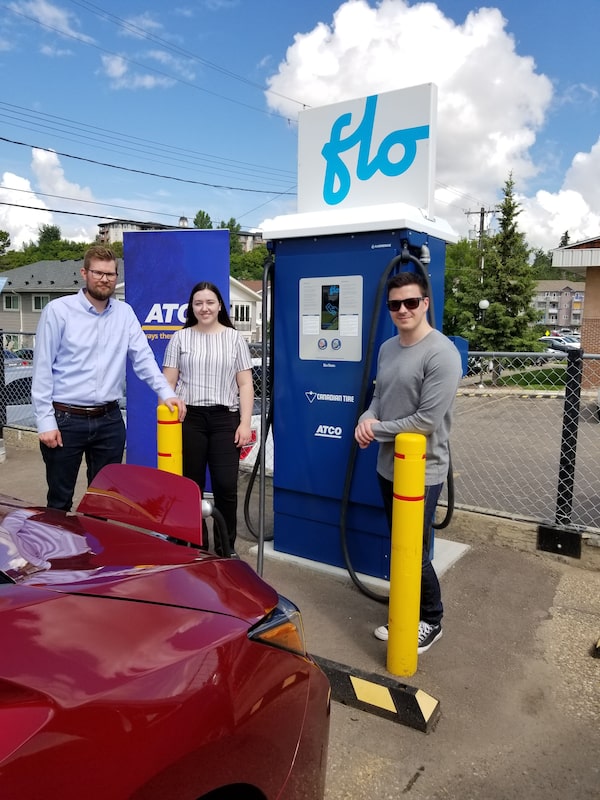
A Hyundai electric vehicle stops in Drumheller, Alta.Doug Firby
Drumheller, Alta., hasn’t quite caught the electric vehicle (EV) fever that is sweeping across Canada’s cities.
One need not look too far to figure out why. The message is clear in the dusty GMC, F-150 and Ram pickup trucks that line the streets of this town of 8,000, about 90 minutes northeast of Calgary. These hard-working people are prudent with their cash and are not inclined to jump on bandwagons.
EV wariness is perhaps also not surprising in an area that is a living monument to the epoch that gave the world fossil fuels. Its Royal Tyrrell Museum holds a massive collection of dinosaur bones. And the sandstone slopes that line the Red Deer River Valley reveal seams of coal that date back 70 million years. Pumpjacks as far as the eye can see still pull thousands of barrels of crude oil from the Earth each day.
Yet, the plug-in hybrid Volvo XC90 that I’ve parked by the Circle K truck stop has caught the eye of Mike Pettis. He stopped by the nearby radio station, Drum FM, to visit his wife, Colette, and asks me whether he can have a look at the car.
“I’ve never been around one, I’ve never driven one,” Pettis says. “That said, my livelihood depends on oil and gas.”
When I acknowledge the name of his employer – a major fossil-fuel transportation company – on his cap, he asks me not to name it in print. He gives me a look that says, you know why.
An hour northwest in Red Deer, a city of 100,000, it is also a lot easier to find EV skeptics than it is to find a charging station. (There is just one Level 3 charger, at the downtown Canadian Tire.)

Bill Phelan of Spruce Grove, Alta., pops by to take a look at a Nissan Leaf during a stop in Red Deer.Doug Firby/The Globe and Mail
“Oil and electricity donʼt mix that well here in this province,” says Bill Phelan of Spruce Grove as he rests against his 2007 Buick Allure outside the Alberta Sports Hall of Fame & Museum. The dozen EVs, hybrids and other fuel-sipping vehicles parked there are on a provincewide tour organized by the Automotive Journalists Association of Canada (AJAC). Like Pettis in Drumheller, Phelan is skeptical but also curious.
“I guess theyʼre coming whether they we like it or not,” he says with a shrug.
Alberta’s rural people, who often drive long, lonely roads in subzero temperatures, are not ready to put their welfare in the seat of today’s limited-range EVs. Yet, in the province’s four biggest cities, it seems the EV shift is nearing a tipping point.
Erin Collins, a CBC reporter based in Calgary, says he’s planning to install solar panels on his house within six months to power an EV or plug-in hybrid that he’ll buy within two years.
“[It] would have been nice to have provincial rebates on both, but they make sense financially right now even without,” Collins says. He’ll buy when he sees the “massive influx” of next-generation EVs coming over the next three years.
Other Calgarians say they like the idea of EVs but are waiting for prices to drop, charging infrastructure to grow and batteries to improve.
“Technically, it isn’t there yet for me,” says Shawn Alain, who runs a social-media-marketing firm in Calgary. “I need to drive from Vancouver to Calgary. Make it [an EV] charge as fast as filling up your tank, and then I’m interested.”
Electrification of vehicles faces several hurdles in Alberta not found in other provinces. Gasoline has recently been selling for less than $1 a litre, while in British Columbia, prices have hit highs of $1.70. The government of Alberta has been slow to subsidize a network of fast-charging stations that are fundamental to overcoming “range anxiety.” And the moral argument – that electricity is a cleaner way to travel – doesn’t hold sway in a province that still generates half of its power from coal, and another 39 per cent from natural gas.
Alberta, like the other Prairie provinces, falls below the 2.5-per-cent national average of electric car adoption. Just next door in B.C. – where gas prices are higher, chargers are more common and more rebates are on offer – 15 per cent of new car sales are for electric cars, according to a report by Blake Shaffer, an energy and environmental economist and adjunct professor at the University of Calgary.
Advocates of subsidies say they help overcome the price premium consumers must pay for going electric. For example, the 2019 Hyundai Kona electric car starts at $44,999 in Canada, according to hyundaicanada.com, while the 2019 gas-powered version starts at $21,099.
The payback on EVs is also longer in Alberta than in some other provinces. Shaffer crunched the numbers and found that in B.C., drivers could save up to $1,600 a year in fuel costs. But in Alberta, it would take between eight and 15 years to pay off the premium paid for an EV, depending on whether it was eligible for a federal rebate.

The Chevy Bolt only had 84 kilometres of range remaining when picked up in Longview, so it needed a charge.Doug Firby
I experienced range anxiety first-hand as one of the participants in AJAC’s annual EcoRun test of high-mileage vehicles. When I climbed into an all-electric Chevy Bolt in the hamlet of Longview, an hour southwest of Calgary, I discovered it had just 84 kilometres left on its charge (a result of an apparent overnight charger malfunction). My destination of Canmore was twice that distance.
Help came from Tyler Smith, who runs an auto-repair shop in nearby Turner Valley. A few years ago, he helped a friend’s son convert an old Triumph sports car into an EV, and in the project, he installed a Level 2 charger at his shop.

Tyler Smith, proprietor of the Shop in Turner Valley, Alta., looks over the 1974 Triumph sports car that he converted to an EV.Doug Firby
It would be several hours for this slow charger to get my Bolt powered up. I grabbed a gasoline-powered car and left the Bolt with Smith for retrieval later.
More chargers are coming to Alberta, though. Atco, a provincial utility, has put fast chargers in Edmonton, Calgary and Red Deer, and is about to add 20 more in communities across the southern part of the province as part of the Peaks to Prairies electric-vehicle-charging-network expansion program. Funded by municipalities, the province, the federal government and corporate partners, the chargers can deliver 80-per-cent charge on a typical EV in 30-45 minutes.
“It could become a new core business for this utility,” says François Blouin, director of innovation for Atco. “It’s a paradigm shift.”
Blouin says Atco is working hard to catch up to other provinces, with the help of municipalities. They are fully committed because they “see the trend” and want to support tourists who may visit the province in EVs. I ask why it has taken so long to build a network.
“We’re in an oil province,” he says.
At the charging station in Red Deer, Atco senior manager of business development Mike Nissen is upbeat.

Will York, Genice Spanier and Mike Nissen are part of the Atco team overseeing the use of Level 3 chargers in Alberta.Doug Firby/The Globe and Mail
“We’ve had great interactions with Albertans,” he says. “They’re just waiting for [EV] trucks to get to the market.”
Putting charging stations in place will make a big difference, but most Albertans are still reluctant to make the leap.
“Not yet,” says Fred Kerr, a Calgary comedian. “I would want to see lower car prices and much better batteries and infrastructure first.”
Sean Myers, a communications professional with the University of Calgary, says his family will look at an EV the next time they’re in the market.
“It feels like Alberta isn’t quite there yet,” he says, “but I could see having one now for trips around the city.”
Editor’s note: A previous version of this article mistakenly said that 15 per cent of new vehicles, a term which encompasses cars, trucks and SUVs, were for electric vehicles. In fact, 15 per cent of new car sales were for electric vehicles. The Globe regrets the error.
Shopping for a new car? Check out the new Globe Drive Build and Price Tool to see the latest discounts, rebates and rates on new cars, trucks and SUVs. Click here to get your price.
Stay on top of all our Drive stories. We have a Drive newsletter covering car reviews, innovative new cars and the ups and downs of everyday driving. Sign up for the weekly Drive newsletter, delivered to your inbox for free. Follow us on Instagram, @globedrive.